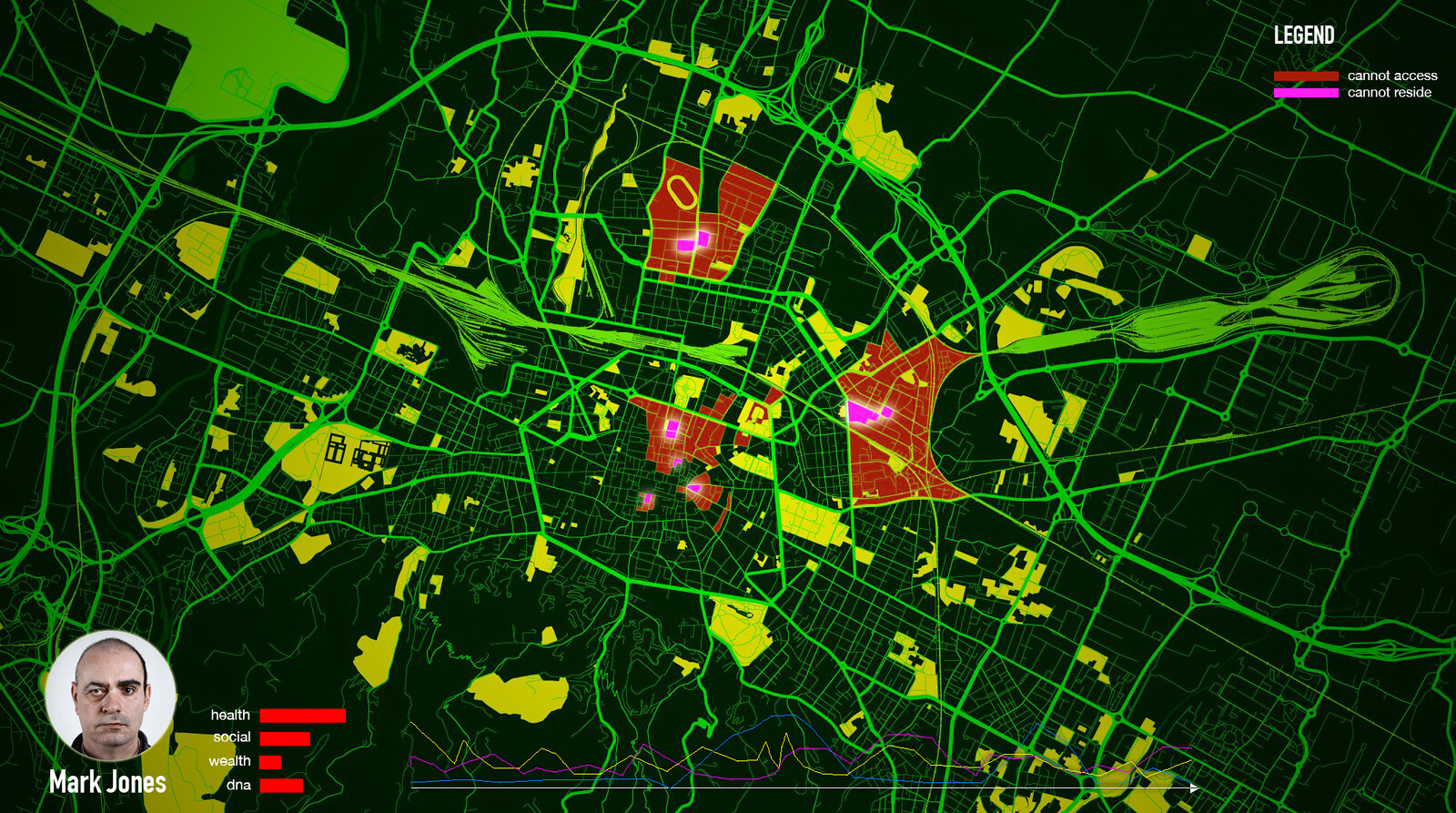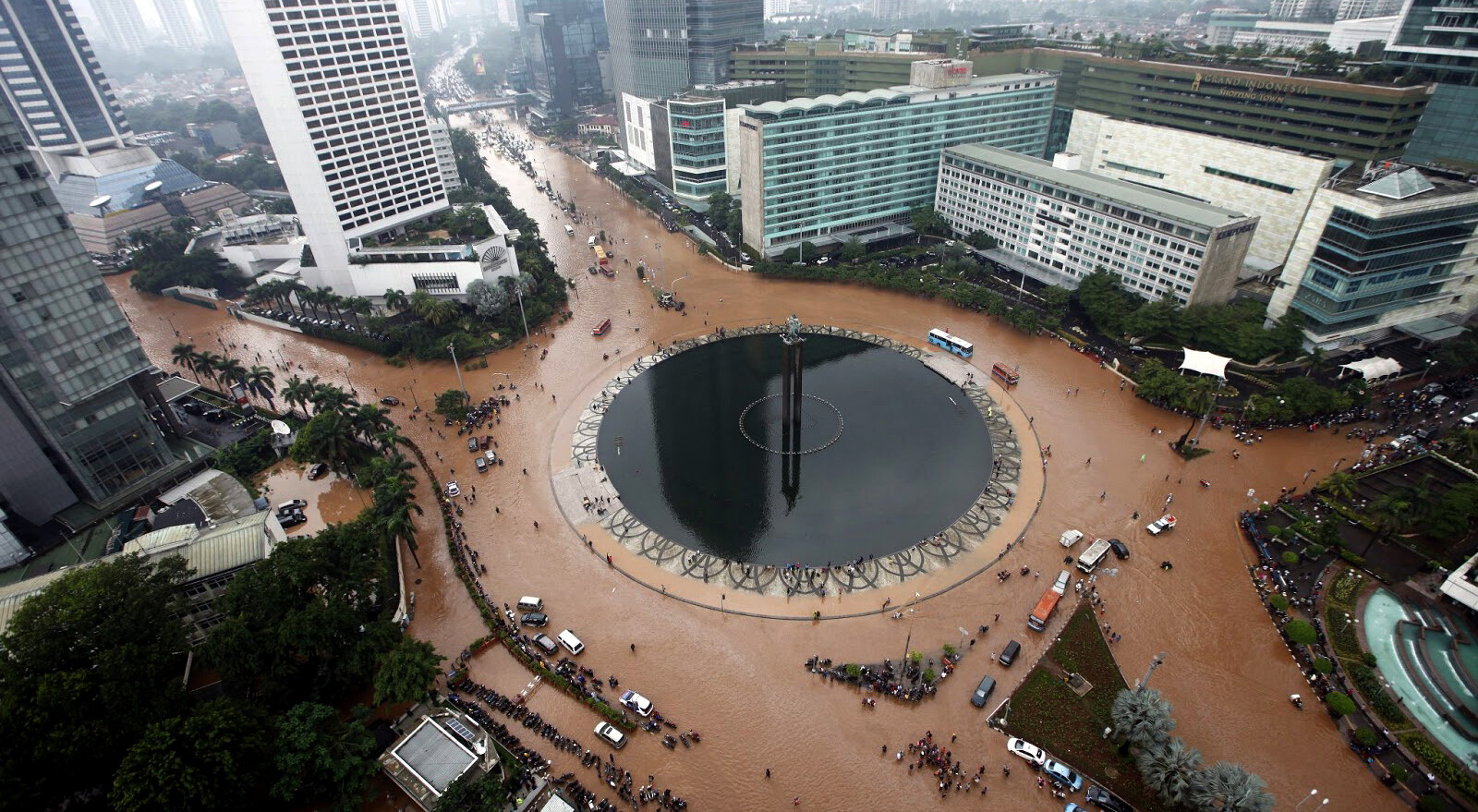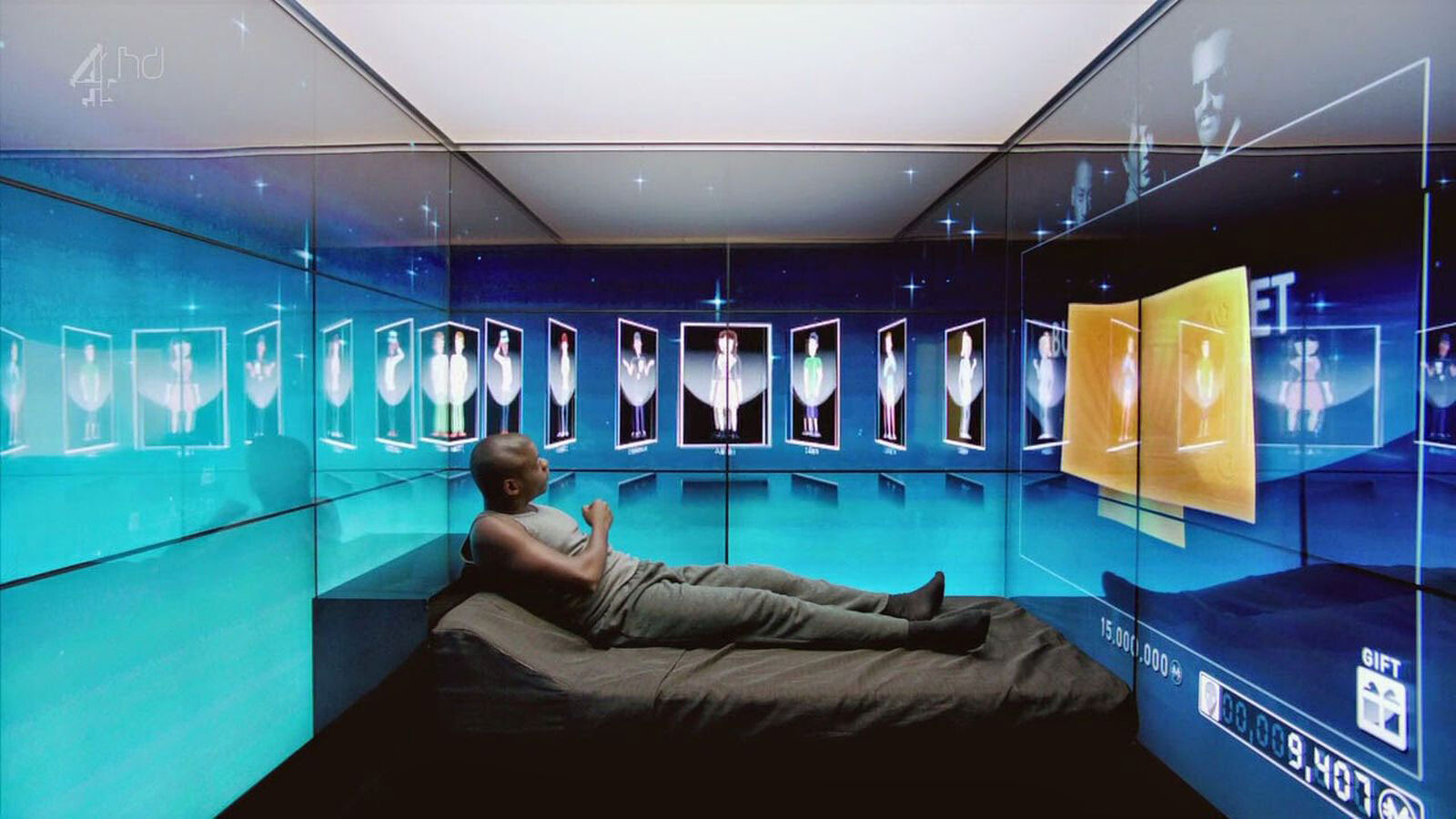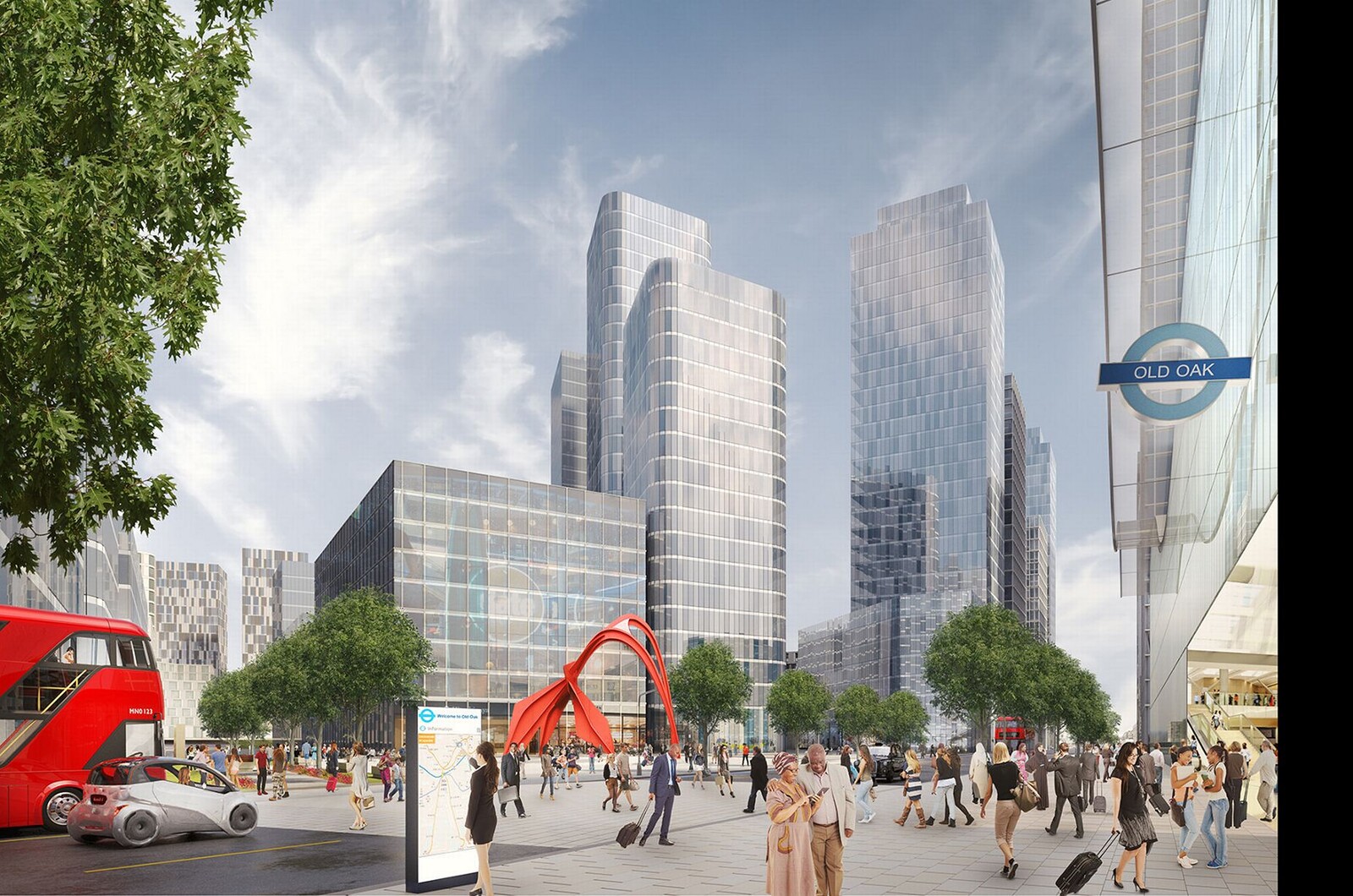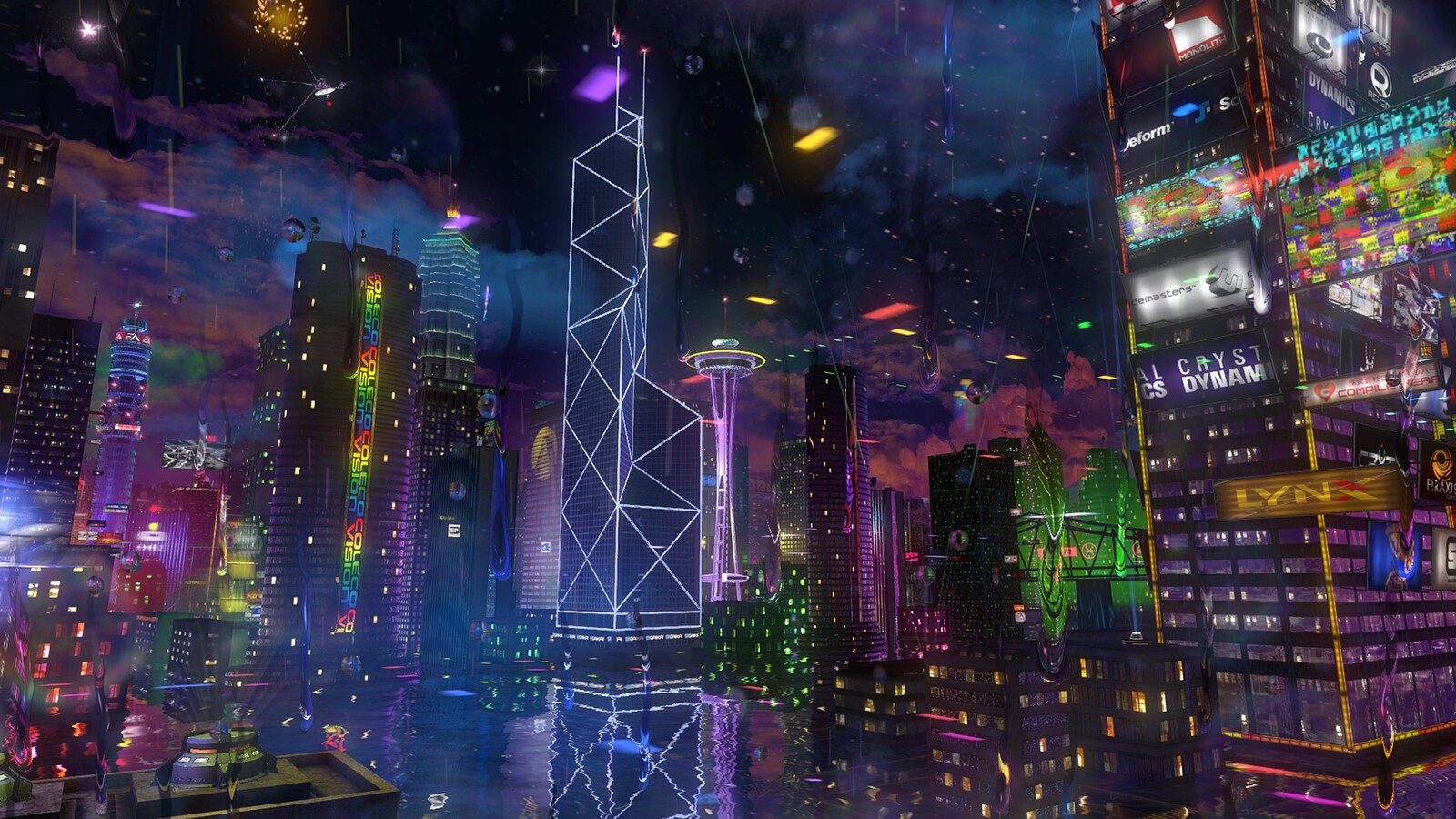The pain was unbearable, like millions of blood-sharp needles poking your skin from the inside, freezing cold, filling all of your neural bandwidth, obstructing any other sensation. But still, I had to go on, I had to see him.
When they first appeared, nobody thought that they would be used in this way.1 Pornography, health, insurance and work; that’s how it all started.2 Wearables, and then chips; first subcutaneous, like evolved tattoos, then implants.3 They were called the next level of augmented and virtual reality; hardware and software not just connected to your central nervous system, but also to your data profiles that would make you feel hitherto impossible, outrageously interactive sensations by connecting with human and non-human others. Then came the insurances, which used the very same technologies to monitor and harvest your body for data in exchange for free medical coverage.4 Then the new types of jobs came: simply install the implant and subscribe to the service. Jobs don’t need to be looked for anymore; by interpreting your physical, emotional, cultural, philosophical data, the job finds you.5 At the start of every day, you receive a message: be here, at this time, to do this.
By 2021 they were the norm. Everybody had one.
As the stimulation fades away, so does the pain.
The map used to be more static: there were places you could go, places you couldn’t, and others you didn‘t even know existed. When looking for a pub to hang out in, a restaurant to eat at, or a neighborhood to buy your next home, places either did, or didn’t show up.6 These places—we called them “gaps”—were simply rendered absent from your perceptive and informational landscape. The government, city administration, corporations, health, education, finance, culture, entertainment, and labor institutions all have their own algorithms, each with their particular agendas, fighting for control over the map, over how much money people in a certain neighborhood should have, or what level of education, or styles, or what sort of relational networks they should be in.7 But recently, everything has become much more dynamic.8 The algorithms don’t just make certain places not appear, but rather filters reviews in such a way to make specific places appear as undesirable; tailored specifically to (or really, against) your tastes of course.9 Ultimately, we all ended up with our own map, designed specifically “for” us.
Backing away and trying another street to the left, I glance down at the printout of my latest CAM (Citizen Accessibility Map) I hacked just yesterday. It’s already out-of-date. My only hope is that it didn’t change too much; that our plan is still valid. When I met him, we had compatible CAMs, for a brief moment. But he was different than me.10
Our city was being torn apart by migration. It took the algorithms a while to adjust to the hundreds of thousands of people arriving. They called it a “systematic invasion.”11 Entire sections of the city became black boxes with corridors for migrants to arrive and others for them to leave when it was deemed time.12 Fake news spread about building collapses and terrorist attacks within these areas, and bots systematically reviewed commercial venues located within negatively. These parts of the city vanished from the map from one day to the next; automated directions began to steer clear of them.13 Some people even got stuck and couldn’t get home as there were no taxis, trains, or buses. Nor was there reliable information on what was happening, when, and where.
This was when the Cross-CAM Inhibition Act was launched: if your CAM didn’t include a certain part of the city, you wouldn’t be able to send messages to anyone or anything within it. This is how places really felt to start disappearing.14 It took about one month to get used to it, but then, like everything else, it became normal. Without asking too many questions you would just follow the directions from the map as before, trust the reviews to find the best deal, restaurant, school to attend, or neighborhood to live.15
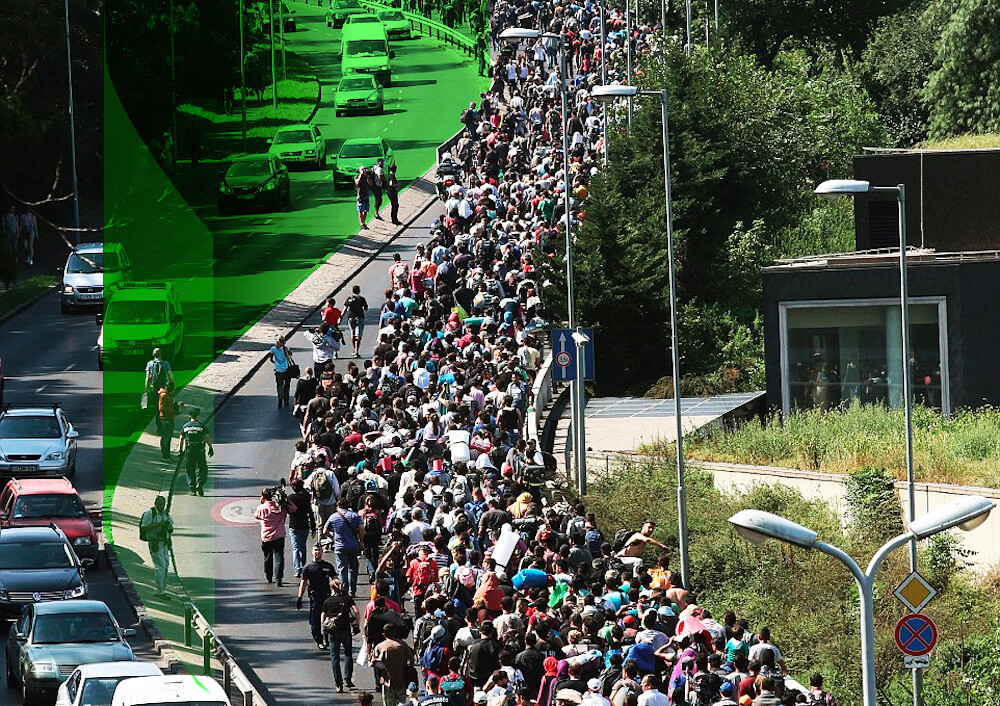

Data-segregation during a migrant crisis.
Beyond this intersection, my map is red. It’s a boundary, but there are no physical barriers.
I can see what’s happening on the other side; there are people who look just like me performing their daily routine. But for them that part of the map is green. Our profiles are different.16 I have to cross in order to get to where we arranged to meet.
We’ve been separated for over a year. We first found ourselves together during the crisis, while the algorithms were adjusting. We were data-locked in the same place, a dark zone; somewhere data “momentarily” disappeared so that the algorithms could figure out what to do.17 Missing data meant missing energy, transport, school, and stores. We were stuck.
We were waiting for a bus that he would have taken to arrive home and to my school a few stops afterwards. With no public transportation, some started to walk towards the edge of the zone. We were among them.
That afternoon, walking together, without data, we fell in love. At first, we didn’t realize we were different, but I had more money than him. I lived in an area that, for him, was invisible. When we separated, we discovered that we couldn’t reconnect, not even communicate. That’s when the pain started.
Stimulation was administered at first only to communicate dangerous situations, such as impending strokes or seizures, or to ensure fluid interaction patterns with robot laborers.18 A small tactile or electrical signal created on the skin, used to communicate data to both people and systems. Actions could be triggered, such as a medication being ingested or injected, or work-related information addressed.19
Both governments and the streets found ways to use these types of technologies in creative ways.20 Together with encrypted communication they were used for new forms of sensual stimulation, to arrange for drugs, and as novel forms of gambling. They were also used to monitor crowd safety, criminal control, and eventually, to manage crowds as they moved.21
Right, right, left, then the corridor. Circuitous paths created through homes, condos, backyards, halls, etc. ad hoc and rented via an app for people like me, people who want to move in and through parts of the city they don’t have access to. Multiple paths are usually connected together to create a corridor and wrapped in isolation material to make it so there is no network coverage inside. If you can’t be detected and monitored, the pain can’t be triggered.
This time, it’s through the hall of a condo, down to the garage floor, out the ramp, then inside the neighboring building, through the apartment on the ground floor and finally down from the balcony and onto the street with a one-and-a-half meter drop. It’s not the most accessible, but at least it’s cheap. And if everything goes as planned, I’ll see him at the end in a blind spot.
Blind spots are where the algorithmic structure doesn’t match reality.22 Hunters and connoisseurs emerged soon after this glitch was discovered who create semi-legal businesses for romantic meetings, illegal trade, gatherings, rave parties and the like.23 In the same way, there were individuals with blind spot profiles, which were either simply not mapped and could thus access everything, or which CAM connection was blocked and their entire map red.
That’s when it happened. As I jumped from the balcony at the end of the corridor, I felt it: the pain. As it started to set in, I could see him in the distance. He was standing on the opposite corner of the street, turning to cross and arrive at where I was supposed to land.
As I hit the ground, he started to collapse. The white noise of the pain completely saturated my senses. As I fainted, I saw him reach under his arm, struggling as if to rip the implant out from his skin. The map had changed again.
Wearable computing first appeared in experiments in 1970s and, then, diffusely in the 2000s. Sonny Consolvo, Sonny et al., “Flowers or a robot army?: encouraging awareness & activity with personal, mobile displays.” Proceedings of the 10th international conference on Ubiquitous computing (2008): 54–63; Mark McClusky, “The nike experiment: How the shoe giant unleashed the power of personal metrics.” Wired, 17(07) (2009), ➝; A. P. Rafferty, A. J. Reeves, H. B. McGee, J. M. Pivarnik, et al., “Physical activity patterns among walkers and compliance with public health recommendations.” Medicine and science in sports and exercise, 34(8) (2002):1255–1261.
Deborah Lupton, “Self-tracking cultures: towards a sociology of personal informatics” Proceedings of the 26th Australian Computer-Human Interaction Conference on Designing Futures: the Future of Design (2014): 77–86.; Jenny Kleeman and Michael Tait, “Rise of the sex robots,” The Guardian (2017), ➝; Evangelos Tziallas, “Gamified Eroticism: Gay Male ‘Social Networking’ Applications and Self-Pornography,” Sexuality & Culture Volume 19, Issue 4 (2015): 759–775; Mark J. Prelert, “IoT Won’t Work Without Artificial Intelligence,” Wired (2014), ➝; Jennifer R. Whitson, “Gaming the Quantified Self” Surveillance & Society 11.1/2 (2013): 163–176.
Javier Andreu-Perez et al., “From Wearable Sensors to Smart Implants-–Toward Pervasive and Personalized Healthcare” IEEE Transactions on Biomedical Engineering, Volume: 62, Issue: 12 (2015): 2750–2762.
Satwant Kaur, “How are the Embedded Chips Going to Affect Our Lives?” IETE Technical Review, Volume 29/2012, Issue 2 (2014): 101–104; Paul M. Schwartz, “Privacy Inalienability And Personal Data Chips.” Privacy and Technologies of Identity (2006): 93–113.
Sarah O’Connor, “When your boss is an algorithm,” Financial Times (2016), ➝; Adam Townsend “Algorithmic Recruiting of Laborers on a Gig platform,” Medium (2017), ➝; Shoshana Zuboff, “Big other: surveillance capitalism and the prospects of an information civilization,” Journal of Information Technology, Volume 30, Issue 1 (2015): 75–89).
Alvin Chang, “How the internet keeps poor people in poor neighborhoods.” Vox (2016), ➝.
Wide control over the maps which are shown in digital applications may lead to being able to enforce financial, political, and cultural agendas. For example, algorithmic control may enable to precisely define how much money, what level of education, style, or relational network people in a certain neighborhood should have, by modulating search results as they are returned to people of different types, effectively making sure that they go or not go in such neighborhoods. Salvatore Iaconesi and Oriana Persico, “Il Terzo Infoscape. Dati, informazioni e saperi nella città e nuovi paradigmi di interazione urbana” In: I Media Digitali e l’Interazione Uomo-Macchina, ed. Simone Arcagni (Rome: Aracne Editore, 2015): 139–168.
Tawanna R. Dillahunt, Christopher A. Brooks, Samarth Gulati, “Detecting and visualizing filter bubbles in Google and Bing.” CHI’15 Extended Abstracts, (Association for Computing Machinery, 2015).
Mark Graham, Matthew Zook, and Andrew Boulton, “Augmented reality in urban places: contested content and the duplicity of code.” Transactions of the Institute of British Geographers, Volume 38, Issue 3 (2012): 464–479.
Seth Flaxman, Sharad Goel, and Justin M. Rao, “Filter Bubbles, Echo Chambers, and Online News Consumption,” Public Opinion Quarterly, Volume 80, Issue S1 (2016): 298-320.
Seth Flaxman, Sharad Goel, and Justin M. Rao, “Ideological Segregation and the Effects of Social Media on News Consumption,” (2014), ➝.
Zeynep Tufekci, “Algorithmic Harms beyond Facebook and Google: Emergent Challenges of Computational Agency,” Colorado Technology Law Journal, 13 (2015): 203.
Patrick Cain, “Fake news: Meet the alternate-reality version of the Quebec City shooting.” Global News (2017), ➝.
Amit Datta, Michael C. Tschantz, and Anupam Datta, “Automated Experiments on Ad Privacy Settings: A Tale of Opacity, Choice, and Discrimination.” Proceedings on Privacy Enhancing Technologies, Volume 2015, Issue 1 (April 2015).
Robert Wabash, “9 Car Accidents Caused by Google Maps & GPS.” The Ranker (2015), ➝; Ibid., Salvatore and Persico (2015); Daniel Gatica-Perez, Salvador R. Correa, and Darshan Santani, “What TripAdvisor Can’t Tell: Crowdsourcing Urban Impressions for Whole Cities.” Digital Polis (Paris: L’Oeil d’Or, 2016).
Ibid., Iaconesi and Persico (2015).
Josh Begley, “How do you measure a military footprint?” (2013), ➝; Trevor Paglen, Blank Spots on the Map: The Dark Geography of the Pentagon’s Secret World (London: Dutton, 2009).
Filippo Sanfilippo and Kristin Y. Pettersen, “A Sensor Fusion Wearable Health-Monitoring System with Haptic Feedback,” Innovations in Information Technology, 11th International Conference (2015); Peter B. Shull, Dana D. Damian, “Haptic wearables as sensory replacement, sensory augmentation and trainer – a review,” Journal of NeuroEngineering and Rehabilitation (2015); Thad Starner et al., “Augmented Reality through Wearable Computing.” Presence, Volume 6, No. 4 (1997): 386–398; P. Milgram, S. Zhai, and D. Drascic, “Applications of augmented reality for human-robot communication,” Proceedings of the 1993 IEEE/RSJ International Conference on Intelligent Robots and Systems (1993); Philip Kortum, HCI Beyond the GUI: Design for Haptic, Speech, Olfactory, and Other Nontraditional Interfaces (Burlington, Massachusetts: Morgan Kaufmann, 2008).
Fritz Breimesser and Arno Fritz, “Pocket monitor for patient cards,” Patent No: US6626358 B1 (2003).
Kate Knibbs, “The Hustler Origins of Wearable Computers.” Gizmodo (2015), ➝.
Jamie Rigg, “Teslasuit does full-body haptic feedback for VR.” Engadget (2016), ➝; William Bogard, “The Coils of a Serpent: Haptic Space and Control Societies”. Ctheory (2007), ➝; Eve Mitleton-Kelly, Ivan Deschenaux, Christian Maag, Matthew Fullerton, and Nihan Celikkaya, “Enhancing Crowd Evacuation and Traffic Management Through AmI Technologies: A Review of the Literature.” Co-evolution of Intelligent Socio-technical Systems (2013).
Micky Lee, “Google ads and the blindspot debate.” Media, Culture & Society, Volume 33, Issue 3 (2011): 433–447; Cynthia Dwork and Deidre K. Mulligan, “It’s Not Privacy, And It’s Not Fair.” Stanford Law Review, (September 2013), ➝; Robert Epstein and Roland E. Robertson, “The search engine manipulation effect (SEME) and its possible impact on the outcomes of elections.” Proceedings of the National Academy of Sciences of the United States of America, Volume 112, No. 33 (2014).
DJ Pangburn, “New Subcultures Surface in the Future-Dystopian Films of Liam Young.” Vice Creators (2017), ➝.
Post-Internet Cities is a collaborative project between e-flux Architecture and MAAT – Museum of Art, Architecture and Technology within the context of the Utopia/Dystopia exhibition and “Post-Internet Cities” conference, produced in association with Institute for Art History, Faculty of Social Sciences and Humanities – Universidade NOVA de Lisboa and Instituto Superior Técnico – Universidade de Lisboa, and supported by MIT Portugal Program and Millennium bcp Foundation.
Category
Subject
Post-Internet Cities is a collaborative project between e-flux Architecture and MAAT – Museum of Art, Architecture and Technology within the context of the Utopia/Dystopia exhibition and “Post-Internet Cities” conference, produced in association with Institute for Art History, Faculty of Social Sciences and Humanities – Universidade NOVA de Lisboa and Instituto Superior Técnico – Universidade de Lisboa, and supported by MIT Portugal Program and Millennium bcp Foundation.
